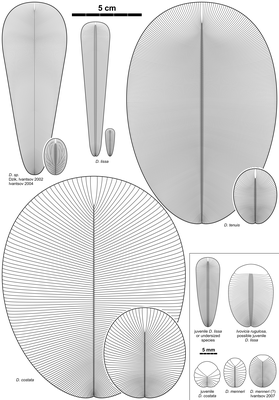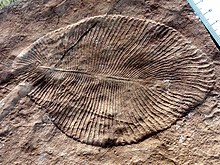Dickinsonia
| Dickinsonia | ||||||||||
|---|---|---|---|---|---|---|---|---|---|---|

Different Dickinsonia species (reconstructions) |
||||||||||
| Temporal occurrence | ||||||||||
| Ediacarium | ||||||||||
| 560 to 555 million years | ||||||||||
| Locations | ||||||||||
| Systematics | ||||||||||
|
||||||||||
| Scientific name | ||||||||||
| Dickinsonia | ||||||||||
| Sprigg , 1947 | ||||||||||
| species | ||||||||||
|
||||||||||
Dickinsonia is a genus of extinct living things . Its representatives lived in the Ediacarium over 555 million years ago and are difficult to compare with living things today. In general, Dickinsonia is considered an early representative of multicellular animals (Metazoa). Its systematic classification is often the many unique aground and therefore difficult to interpret characteristics of the fossils of Dickinsonia controversial. A classification into the realm of mushrooms and the assignment to an extinct realm were also discussed.
features
Dickinsonia fossil finds show great variability in size. Based on these findings, the representatives of this genus were between 4 mm and 1.40 m tall and only a few millimeters thick. Most of the representatives were oval in shape. The relief of the Dickinsonia fossils is characteristic. Starting from a central furrow, the body is criss-crossed by numerous other furrows.
The fossils found leave a lot of scope for interpretation. Some palaeontologists around Adolf Seilacher assume that Dickinsonia was a particularly simply built, possibly single-celled living being that resembled a "liquid-filled air mattress". Other scientists assume a more complex organism. For example, the central furrow was interpreted as an intestine. Earlier interpretations that Dickinsonia had both a mouth and an anus are rarely shared today. The furrows emanating from the central furrow indicate possible segmentation of the body. The body itself has - depending on the interpretation - bilateral or sliding mirror symmetry . Its ends, called the A-end and B-end, can be distinguished from one another. The occasional use of the term “anterior” (front) for the B-end and “posterior” (rear) for the A-end is considered controversial.
The body shape and segmentation is also used to differentiate the Dickinsonia species. Dickinsonia lissa differs from all other members of the genus by its elongated shape. Fossils of Dickinsonia tenius and Dickinsonia costata can be distinguished from one another based on the density of the furrows. Dickinsonia menneri is the only representative of the genus to have a pronounced "head" segment. Dickinsonia rex is by far the largest representative of the genus.
Way of life
As trace fossils from the Ediacara Hills in South Australia show, Dickinsonia and his closest relatives were able to move actively.
It is believed that Dickinsonia used a feeding mechanism that is only used today by representatives of the Placozoa tribe . Fossil traces indicate that Dickinsonia grazed over lawns of microorganisms on the ocean floor, digested them externally and ingested them with the help of the entire ventral surface.
Systematics
Even if the systematic classification of Dickinsonia is problematic, this genus is mostly assigned to the realm of multicellular animals. Within this realm, Dickinsonia was associated in particular with today's cnidarians , poly-bristles and vortex worms . Alternatively, Dickinsonia has also been interpreted as an early ancestor of the chordates . The type of food intake suggests a relationship with Placozoa.
An assignment of Dickinsonia to other realms of living beings was also discussed. Assuming a symbiosis with photosynthetic microorganisms, Dickinsonia was also assumed to be a genus of lichen- forming fungi. Dickinsonia is often assigned to the hypothetical and extinct tribe of the Vendobionts , which are interpreted, among other things, as gigantic single-celled organisms and assigned to the protozoa .
In September 2018, a study was published in the journal Science , according to which Dickinsonia is actually a multicellular animal. To arrive at this result, well-preserved Dickinsonia fossils , around 558 million years old, were examined, which had been recovered from a cliff on the coast of the White Sea in Arctic Russia. These still contained biomarkers that resulted from the breakdown of animal fats. 93 percent of biomarkers consist of molecules that are similar to cholesterol , a compound that is typical of animal life forms. Only 1.8 percent of the biomarkers consisted of residues of compounds that are characteristic of fungi and lichens. The molecules typical of unicellular organisms are also largely absent.
Discovery story
Dickinsonia was discovered in fossil form by the discoverer of the Ediacara fauna , the Australian geologist Reginald Claude Sprigg , and scientifically described in 1947. Sprigg named the fossil after Ben Dickinson , the then director of the mines of South Australia . The decoding of the fossil posed numerous problems for science. Sprigg himself described it as the fossil of a jellyfish, Harrington and Moore assigned Dickinsonia to the tribe of the cnidarians in 1956. Glaessner and Wade, on the other hand, saw a relationship with the annelid worms in 1966 . Although the fossils show little resemblance to typical annelid worms, they do show aberrant annelworm forms such as spinters . Sidnie Manton decidedly rejected this interpretation as early as 1967, but it has remained in textbooks to this day. Due to their uncertainty, however, an ongoing discussion about the scientific classification of Dickinsonia developed .
literature
- Xiao S, Laflamme M: On the eve of animal radiation: phylogeny, ecology and evolution of the Ediacara biota . In: Trends Ecol. Evol. (Amst.) . 24, No. 1, January 2009, pp. 31-40. doi : 10.1016 / j.tree.2008.07.015 .
- Brasier MD, Antcliffe JB: Dickinsonia from Ediacara: A new look at morphology and body construction . In: Paleo . 270, 2008, pp. 311-323. doi : 10.1016 / j.palaeo.2008.07.018 .
Web links
Individual evidence
- ^ Retallack GJ: Growth, decay and burial compaction of Dickinsonia, an iconic Ediacaran fossil . In: Alcheringa: an Australasian Journal of Palaeontology . 31, No. 3, 2007, pp. 215-240. doi : 10.1080 / 03115510701484705 .
- ↑ a b Seilacher A, Grazhdankin D, Legouta A: Ediacaran biota: The dawn of animal life in the shadow of giant protists . In: Paleontological Research . 7, No. 1, 2003, pp. 43-54.
- ^ Scott D. Evans, James G. Gehling, Mary L. Droser: Slime travelers: Early evidence of animal mobility and feeding in an organic mat world. geobiology, June 2019, doi: 10.1111 / gbi.12351
- ↑ a b Sperling EA, Vinther J: A placozoan affinity for Dickinsonia and the evolution of late Proterozoic metazoan feeding modes . In: Evolution & Development . 12, No. 2, 2010, pp. 201-209. doi : 10.1111 / j.1525-142X.2010.00404.x .
- ↑ Retallack GJ: Were the Ediacaran Fossils Lichens? . In: Paleobiology . 20, No. 4, 1994, pp. 523-544.
-
^ Ilya Bobrovskiy, Janet M. Hope, Andrey Ivantsov, Benjamin J. Nettersheim, Christian Hallmann, Jochen J. Brocks: Ancient steroids establish the Ediacaran fossil Dickinsonia as one of the earliest animals . In: Science . tape 361 , no. 6408 , September 21, 2018, p. 1246–1249 , doi : 10.1126 / science.aat7228 . This fossil is one of the world's earliest animals, according to fat molecules preserved for a half-billion years. On: sciencemag.org from September 20, 2018
- ^ Sprigg RC: Early Cambrian (?) Jellyfishes from the Flinders Ranges, South Australia . In: Transactions of the Royal Society of South Australia . 71, 1947, pp. 212-224.
- ↑ Harrington HJ, Moore RC : Medusa of the Hydroidea . In: Moore RC (Ed.): Treatise on Invertebrate Paleontology, Part F: Coelenterata . GSA and University of Kansas Press, Kansas 1956, pp. 77-80.
- ^ Glaessner MF, Wade M: The late Precambrian fossils from Ediacara, South Australia . In: Palaeontology . 9, 1966, pp. 599-628.
- ^ Manton SM: The polychaete Spinther and the origin of the Arthropoda . In: Journal of Natural History . 1, 1967, pp. 1-22.


